This step by step diy woodworking project is about a 14×10 wooden gable pavilion plans. I’ve designed this wide gazebo with just 4 posts so you can make the most of the outdoor space. This pavilion has generous overhangs on all sides and it will create a nice area for relaxation and socialization with the loved ones. Make sure you take a look over the local building codes, so you comply with the regulations. Take a look over the rest of our woodworking plans, if you want to get more building inspiration. Check out the Shop, as well, for full list of Premium Plans.
This project is perfect for adding a stylish and functional space to your backyard, whether you’re hosting a BBQ or just relaxing with family. Plus, with my easy-to-follow plans, you’ll have this beauty built in no time! I can’t wait to see how you customize it to make it your own.
When buying the lumber, you should select the planks with great care, making sure they are straight and without any visible flaws (cracks, knots, twists, decay). Investing in cedar or other weather resistant lumber is a good idea, as it will pay off on the long run. Use a spirit level to plumb and align the components, before inserting the galvanized screws, otherwise the project won’t have a symmetrical look. If you have all the materials and tools required for the project, you could get the job done in about a day. See all my Premium Plans HERE.
Projects made from these plans
14×10 Gable Pavilion Plans – DIY Plans
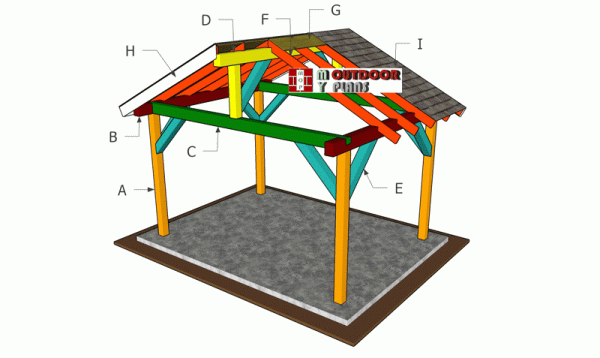
Building-a-14×10-gable-pavilion
Cut + Shopping Lists
A – 4 pieces of 6×6 lumber – 8 ft POSTS
B – 2 pieces of 6×8 lumber – 12 ft SIDE TOP BEAMS
C – 2 pieces of 6×8 lumber – 14 ft CROSSBEAMS
D – 2 pieces of 6×6 lumber – 33 3/8” long, 1 piece of 6×8 lumber– 14 ft RIDGE BEAMS
E – 10 pieces of 6×6 lumber – 42” BRACES
F – 14 pieces of 2×6 lumber – 110” RAFTERS
G – 4 pieces of 3/4” plywood – 4’x8’, 4 pieces – 4’x4’, 2 pieces – 48”x14”, 2 pieces –96”x14” ROOF SHEETS
H – 2 pieces of 1×8 lumber – 12’, 4 pieces – 11 1/8” ROOF TRIMS
I – 250 ft of tar paper, 250 ft of asphalt shingles ROOFING
Tools
![]() Hammer, Tape measure, Framing square, Level
Hammer, Tape measure, Framing square, Level
![]() Miter saw, Drill machinery, Screwdriver, Sander
Miter saw, Drill machinery, Screwdriver, Sander
Time
Related
- PART 1: 14×10 Pavilion Plans
- PART 2: 14×10 Pavilion Roof Plans
It’s that easy to build a gable pavilion!
How to build a 14×10 pavilion – laying out
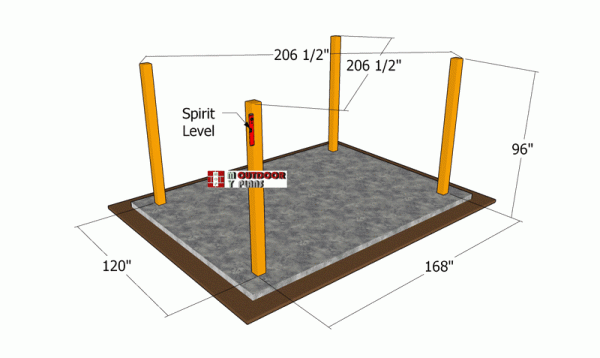
Laying-out-the-posts—14×10
First, layout the posts for the 14×10 gable pavilion. Use batter boards and string to determine the location of the posts. Apply the 3-4-5 rule to every corner of the pavilion, so you make sure they are right angled. Make sure the diagonals are equal and make adjustments if necessarily.
Determining the location for the pavilion is essential, as you have to comply with the local building codes. Make sure the surface is level and remove the vegetation layer.
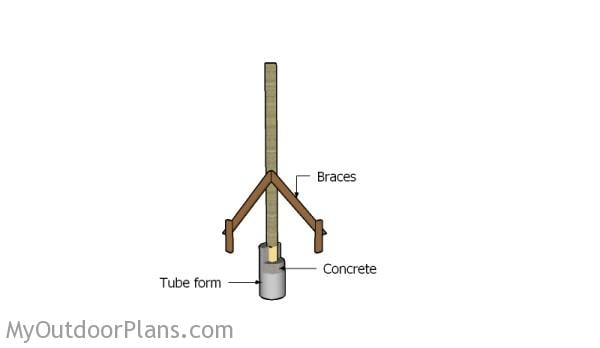
Setting the posts in concrete
Dig 3 ft holes into the ground, making sure they have about 12″ in diameter. Fit the tubes then the posts into the ground and plumb them with a spirit level. Use temporarily braces to make sure the posts are locked into placed while filling the holes with concrete. Let the concrete dry out for several days. Read the local codes for more details on how to secure the posts.
Use lag screws to secure the posts to the anchors. Before pouring the concrete you need to make sure the top of the posts are horizontal one to another. Use a laser to mark the level to the top of the posts and use a circular saw, if you need to make cuts.
Building the frame of the large pavilion
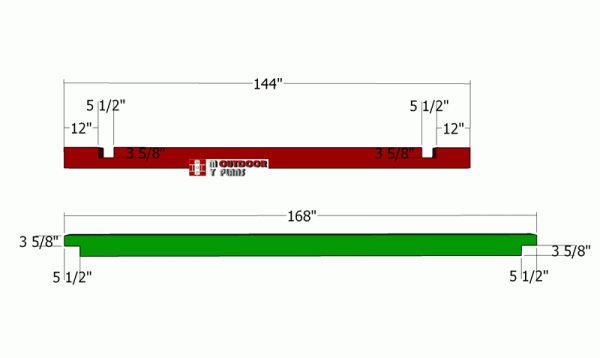
Top-plates
Use 6×8 lumber for the rails. Mark the cut lines on the beams and then make the cut outs with a circular saw and a chisel. Smooth the surface with sandpaper. Use 6×8 lumber for the other rails. Set the circular saw at 3 5/8″ and then make parallel cuts inside the marked areas. Clean the recess with a chisel, a hammer and sandpaper.
You need 2 pieces for the side top plates and 2 pieces for the crossbeams.

Fit the top rails to the sides of the pavilion. Notice the 12″ overhangs to the front and back of the pavilion. Drill pilot holes through the plates and insert 8″ screws to lock them to the posts. Use 2 screws for each joint. Make sure the corners are square and plumb the posts vertically.
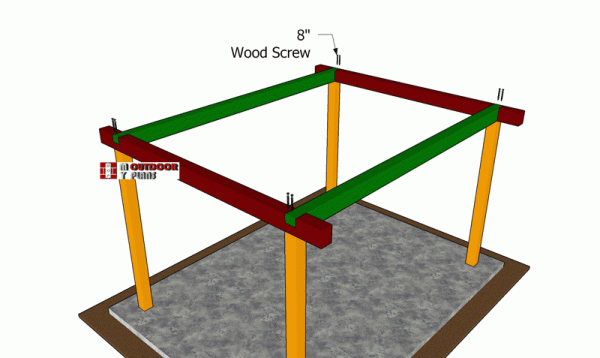
Fitting-the-crossbeams
Fit the cross plates to the pavilion. Align the edges flush and drill pilot holes. Insert the 8″ screws to lock the cross plates into place tightly.
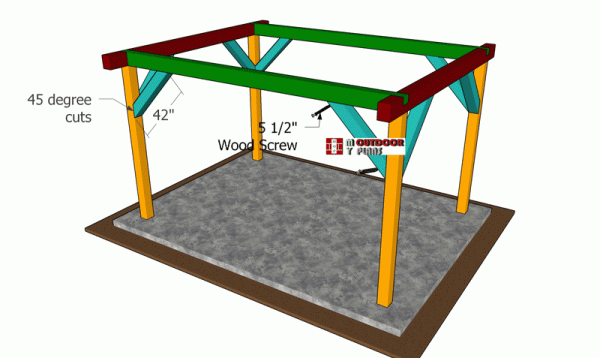
Fitting-the-braces
Build the braces for the front and back of the pavilion from 6×6 lumber. Use a miter saw to make 45 degree cuts to both ends of the braces. Fit the braces to the posts, after you plumb them vertically. Drill pilot holes and insert 5 1/2″ screws to secure the braces into place tightly. Insert 2 screws for each joint.
The braces will reinforce the rigidity of the pavilion and prevent lateral movements due to wind.
Building the roof of the pavilion
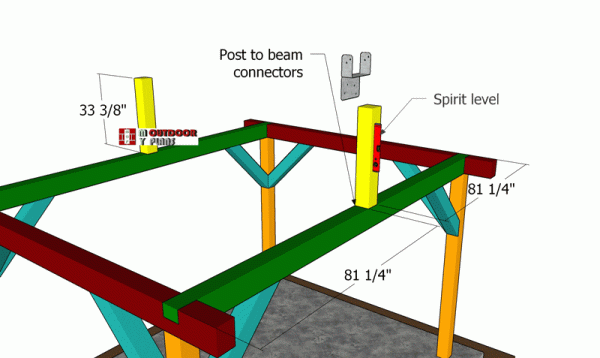
Ridge-beam-supports
Center the 6×6 supports to the top of pavilion. Plumb the supports with a spirit level. Use post to beam connectors and 2 1/2″ structural screws to secure the supports to the frame of the pavilion.
Remember that the height for this posts is designed for a corresponding 6:12 pitch. If you want a different pitch for your project you need to start by changing the height of these supports.
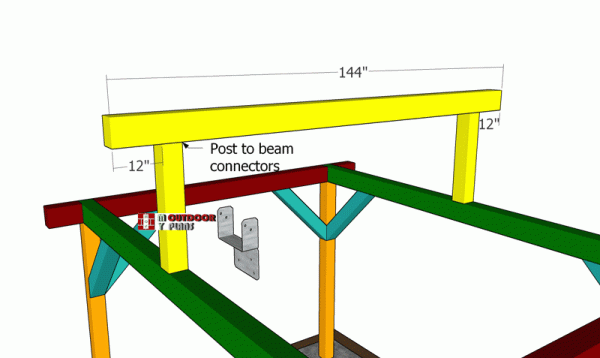
Fitting-the-ridge
Fit the 6×8 ridge beam to the supports with post to beam connectors. Make sure the corners are square. Notice the 12″ overhangs to the front and back, similar to the side plates. Use 2 1/2″ structural screws to lock the connectors into place.
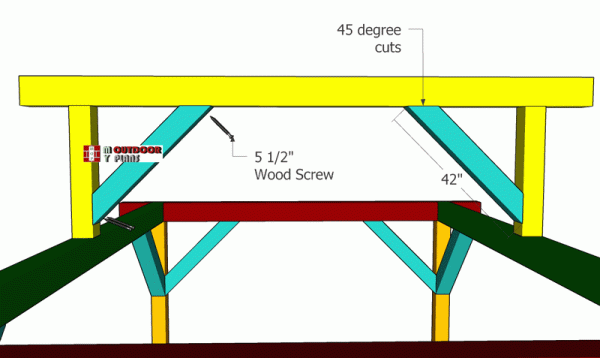
Ridge-beam-braces
Use 6×6 lumber for the braces. Make 45 degree cuts at both ends of the braces. Secure the braces into place with 5 1/2″ screws. Drill pilot holes before inserting the screws. As usual, use 2 screws for each joint.
Finishing touches
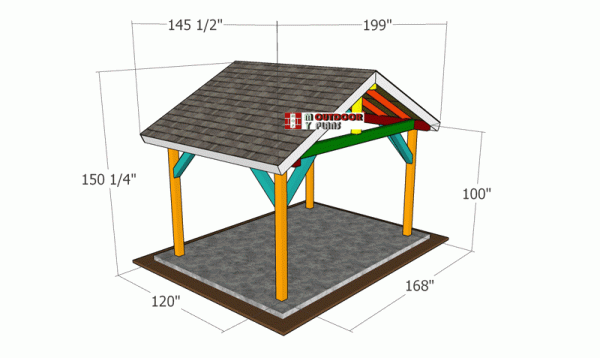
14×10-Pavilion-Plans—overall-dimensions
Check out PART 2 of the project to learn how to build the gable roof. See the overall dimensions of this pavilion in the image above.
Building a 14×10 gable pavilion comes with some wonderful advantages! First, it creates a perfect spot for outdoor gatherings, providing shade and shelter for your family and friends. Second, the gable design adds a touch of charm and elegance to your backyard, making it a beautiful focal point. Plus, it’s a versatile space—you can use it for dining, relaxing, or even as a cozy retreat for reading or napping.
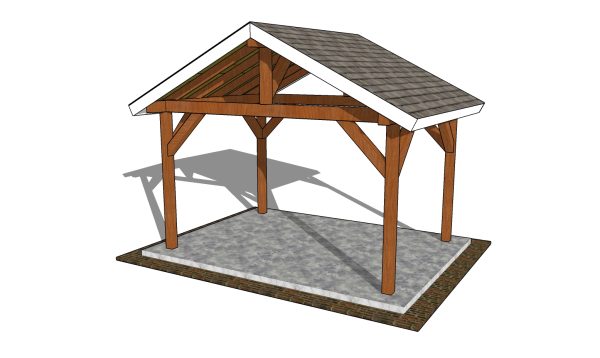
14×10 Pavilion Plans
Fill the holes with wood putty and let them dry out for a few hours. Smooth the surface with 100-220 grit sandpaper and remove the residues with a damp cloth.
For the cost estimate, you’re looking at roughly $800-$1,200 for all the lumber and framing materials. Add in about $300-$500 for roofing materials and another $100-$200 for hardware like screws and nails. So, overall, the project will run you around $1,200-$2000, making it a budget-friendly way to add a beautiful pavilion to your backyard!
Top Tip: Apply a few coats of paint or stain to the components, to enhance the look of the project. Premium Plans for this project available Here. Check out the Shop, as well, for full list of Premium Plans. Press the GET PDF PLANS button bellow, if you want to get the Premium Plans with the full Cut and Shopping lists included, as well as with the cut layout diagram.
This woodworking project was about 14×10 gable pavilion plans. If you want to see more outdoor plans, check out the rest of our step by step projects and follow the instructions to obtain a professional result.
EXPLORE MORE IDEAS FOR:
 |
 |
 |
 |


